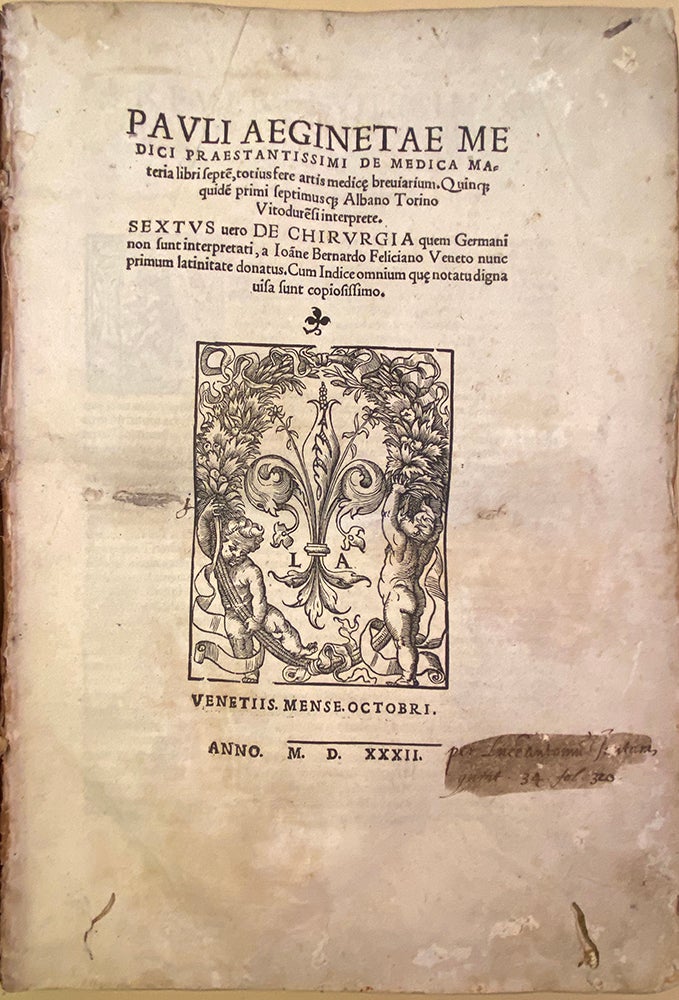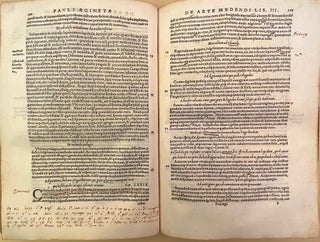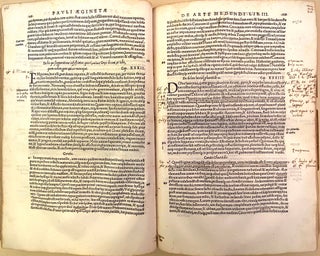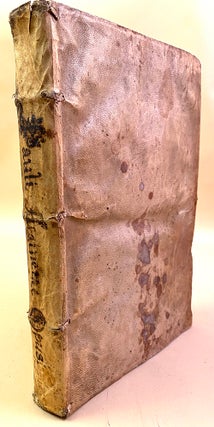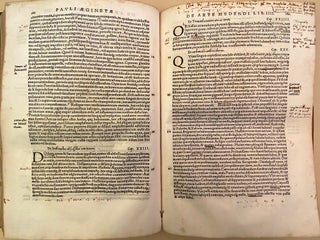De medica materia. Includes the 16th book on surgery.
Publisher Information: 1532.
Paul of Aegina (fl. 640). De medica materia libri septe[m], totius fere artis medic breviarum . . . Albano Torino Vitodure[n]si interprete . . .Sextus vero de chirurgia quem German non sunt interpretati, a Ioane Bernardo Feliciano Veneto nunc primum latinitate donatus. Folio. [28], 438pp. Venice: Lucantonio Giunta, 1532. 306 x 215 mm. 16th-century limp vellum, title inked on spine, some soiling and spotting, a few wormholes. Minor foxing and toning, some marginal worming in the first several leaves not affecting text, tear in leaf b4 (pp. 19-20). Very good. Extensively annotated in a 16th-century hand (some notes trimmed). “Luca Antonio I . . . tam,” i.e. the publisher's name, inscribed and partially obscured on title page near the date.
First Complete Edition in Latin of Paul of Aegina’s Epitome, which was first published in the original Greek by the Aldine Press in 1528. The Giunta edition used the Latin translation by A. Torinus published earlier in 1532 by Cratander, but included the Epitome’s sixth book on surgery which had been omitted from the Cratander edition. This copy has been extensively annotated in a 16th-century hand by a well-educated reader who knew Greek and was familiar with medical literature; the notes contain numerous references to Oribasius, Rhazes, Isidore, Celsus, Dioscorides, Guinter von Andernach and other medical authors. It is possible that the notes were made in preparation for another edition, or that they were written by a 16th century medical scholar as a key to Paul of Aegina’s work.
Paul of Aegina was the most important physician of his day and a skillful surgeon. His Epitome summarizes Greek medical thought and the Galenic tradition and was highly important for the transmission of classical medicine to Islamic and European physicians. The Epitome is divided into seven books on hygiene, fevers, bodily afflictions, surgery, medicines and poisons. It includes material on dietary therapeutics describing many foods; an analysis of the pulse as a prognostic tool, with a classification of sixty-two varieties of pulse; an excellent discussion of the kidneys, liver and spleen; diseases of the uterus and complications of labor; the first clear description of the effects of lead poisoning, and a discussion of ninety minerals, six hundred plants and one hundred sixty-eight animals from Dioscorides.
Paul’s book on surgery, however, is his single most important contribution. It represents the most complete system of operative surgery to come down from ancient times. Paul gives original descriptions of lithotomy, trephining, tonsillotomy, paracentesis and amputation of the breast. He was one of the earliest writers on plastic surgery, discussing operations on the eyelids, nose, lips and ears. He gives prescriptions for the treatment of burns, discusses military surgery, obstetrics and surgery of the eye. “Because of the completeness of his work, the conciseness and lucidity of his descriptions, and the systematic organization of his books, large portions of [Paul’s] writings were incorporated into the texts of the principal Arabic authors. In surgery, in particular, he literally transmitted the entire body of Greek and Roman knowledge to Islam whence it ultimately returned to medieval and pre-Renaissance Europe” (Zimmerman & Veith, Great Ideas in the History of Surgery, p. 75). See Garrison-Morton.com 36 and 5549.
Book Id: 46044Price: $8,500.00

